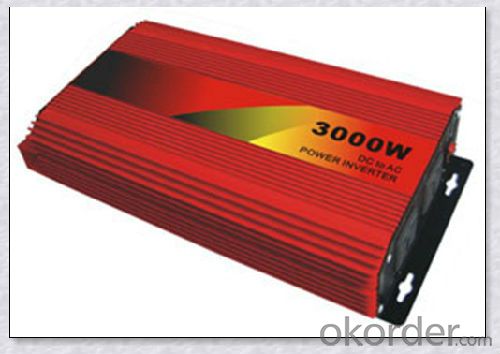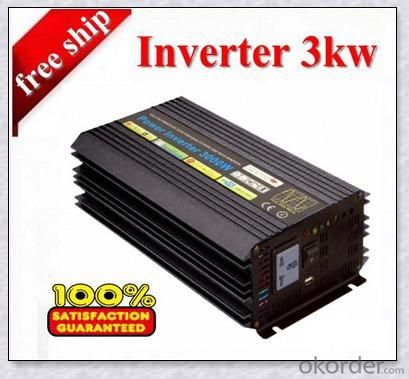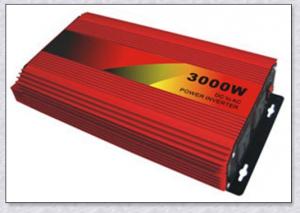Solar Inverter 24V 3000W Leading-Edge Technology
OKorder Service Pledge
OKorder Financial Service
You Might Also Like
Descriptions:
All of our grid-tie inverters are UL listed and code-compliant. We do not stock refurbished grid-tie inverters. Because grid-tie inverters have stricter requirements than off grid inverters, refurbished grid-tie inverters may not be code-compliant. Check with your local electrician or building department before investing in a refurbished grid-tie inverter.

Specifications
INPUT | |
Input voltage range | 185~265±5Vac |
OUTPUT | |
Output voltage range | 185~265±5Vac (AC mode) , 230Vac (DC mode) |
Output frequency (DC mode) | 50Hz (48~54Hz) or 60Hz(58~64Hz), same as AC(AC mode) 50Hz ±0.3Hz (DC mode) |
Wave form | Sine wave (DC Mode) |
Transfer time | 10ms. (Typical) |
BATTERY | |
Rated charging current (max.) | 45A |
Norminal DC input voltage | 24V |
Min. DC start voltage | 20V / 40V |
PHYSICAL | |
Unit dimension (mm) | 526*277*212 |
Master box dimension (mm) | 620*350*370 |
Net weight (1pc, kg) | 32.4 |

Electronic Protections:
·PV short circuit protection
·PV reverse polarity protection
·PV overvoltage alarm protection
·PV over current protection
·Battery overcharge protection
·Battery over discharge protection
·Battery reverse polarity protection
·Load short circuit protection
·Load overload protection
FAQ:
Q: Do you have any MOQ limit?
Our MOQ is 200 pieces.
Q: Do you offer guarantee for the products?
Yes, we offer one year guarantee for the products.
- Q:How do you calculate the total power capacity for a solar inverter?
- To calculate the total power capacity for a solar inverter, you need to consider the maximum power output of the solar panels. This value is typically given as the DC power rating in watts. The inverter capacity should be equal to or slightly higher than the total DC power rating of the connected solar panels. This ensures optimal performance and avoids any power loss. Additionally, other factors such as the inverter's efficiency, temperature derating, and future expansion plans should also be taken into account when determining the total power capacity for a solar inverter.
- Q:Can a solar inverter be connected to a battery backup system?
- Yes, a solar inverter can be connected to a battery backup system. This allows for the excess solar energy generated during the day to be stored in the batteries for use during times when there is less sunlight or during power outages.
- Q:How does a solar inverter affect the overall aesthetics of a solar installation?
- A solar inverter does not have a direct impact on the overall aesthetics of a solar installation as it is typically installed indoors or in a separate enclosure. The inverter's primary function is to convert the DC electricity generated by the solar panels into usable AC electricity for consumption. However, it is important to choose an inverter that is compatible with the installation's design and size to ensure efficient operation and minimal visual impact.
- Q:How does a solar inverter handle variations in solar panel tilt and orientation?
- A solar inverter handles variations in solar panel tilt and orientation by continuously monitoring the output voltage and current of the solar panels. It then adjusts the power conversion process to optimize the efficiency of power generation based on the tilt and orientation of the panels. This ensures that maximum power is extracted from the solar panels regardless of their position, allowing for optimal energy production.
- Q:Can a solar inverter be used with thin-film solar panels?
- Yes, a solar inverter can be used with thin-film solar panels. Thin-film solar panels have a different structure and composition compared to traditional crystalline silicon panels, but they still generate DC electricity that needs to be converted into AC for use in homes or businesses. A solar inverter is responsible for this conversion process, regardless of the type of solar panels used.
- Q:What is the maximum temperature range for a solar inverter?
- The maximum temperature range for a solar inverter typically varies between -25°C to 60°C (-13°F to 140°F).
- Q:What is the role of a solar inverter in a solar panel system?
- The role of a solar inverter in a solar panel system is to convert the direct current (DC) generated by the solar panels into alternating current (AC) that can be used to power household appliances and be fed into the electrical grid. It also ensures maximum power output and efficiency from the solar panels by constantly tracking the maximum power point.
- Q:Can a solar inverter be used in a mobile or portable solar system?
- Yes, a solar inverter can be used in a mobile or portable solar system. Portable solar systems typically consist of solar panels, a battery, and an inverter. The solar panels generate electricity from the sun, which is stored in the battery. The inverter then converts the stored DC power from the battery into AC power that can be used to power various devices and appliances. This allows for the utilization of solar energy even in remote or mobile settings.
- Q:How do you calculate the power loss in a solar inverter?
- To calculate the power loss in a solar inverter, you need to determine the difference between the input power and the output power. Subtracting the output power from the input power will give you the power loss.
- Q:Can a solar inverter be integrated with energy management systems?
- Yes, a solar inverter can be integrated with energy management systems. By connecting a solar inverter to an energy management system, it allows for better monitoring, control, and optimization of the solar power generated. This integration enables efficient management of energy consumption, storage, and distribution, leading to increased energy efficiency and cost savings.
1. Manufacturer Overview |
|
|---|---|
| Location | |
| Year Established | |
| Annual Output Value | |
| Main Markets | |
| Company Certifications | |
2. Manufacturer Certificates |
|
|---|---|
| a) Certification Name | |
| Range | |
| Reference | |
| Validity Period | |
3. Manufacturer Capability |
|
|---|---|
| a)Trade Capacity | |
| Nearest Port | |
| Export Percentage | |
| No.of Employees in Trade Department | |
| Language Spoken: | |
| b)Factory Information | |
| Factory Size: | |
| No. of Production Lines | |
| Contract Manufacturing | |
| Product Price Range | |
Send your message to us
Solar Inverter 24V 3000W Leading-Edge Technology
OKorder Service Pledge
OKorder Financial Service
Similar products
New products
Hot products
Hot Searches
Related keywords































